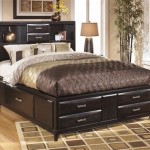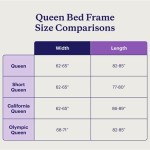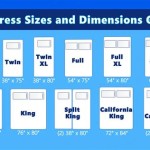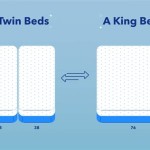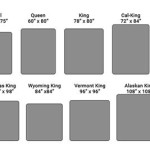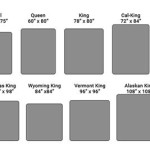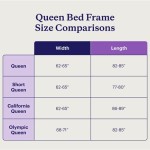Queen Size Bed Measurement In Feet: A Comprehensive Guide
The queen size bed is a popular choice for individuals, couples, and guest rooms due to its balance of space and comfort. Understanding the precise dimensions of a queen size bed, particularly when expressed in feet, is crucial for planning bedroom layouts, selecting appropriate bedding, and ensuring compatibility with existing furniture.
While the term "queen size" offers a general idea of the bed's size, it's the specific measurements in feet that provide practical information for real-world applications. This article will delve into the standard measurements of a queen size bed, exploring related dimensions and considerations for different bed frames and room sizes.
Standard Queen Size Bed Dimensions in Feet
The standard queen size mattress measures approximately 5 feet wide by 6.67 feet long. When converted to inches, this translates to 60 inches wide by 80 inches long. These measurements are widely accepted as the industry standard for queen size mattresses in the United States and other regions adhering to similar sizing conventions.
It is important to note that these dimensions refer specifically to the mattress itself. The overall footprint of the bed, including the frame, headboard, and any additional features, will typically exceed these measurements. The specific dimensions of the frame will vary depending on the design and style of the chosen bed frame. A simple platform bed might add only a few inches to each side, while an elaborate sleigh bed with a large headboard and footboard could add significantly more.
Therefore, when planning a bedroom layout, it is imperative to consider the overall dimensions of the bed, including the frame, rather than solely relying on the mattress dimensions. This will ensure adequate space for movement around the bed and prevent overcrowding in the room.
While the 5 feet by 6.67 feet (60 inches by 80 inches) measurement is the standard, it is also crucial to consider slight variations that may exist across different manufacturers. Minor deviations of an inch or two are not uncommon, particularly in the length of the mattress. Therefore, it is always recommended to verify the exact dimensions of the specific mattress and bed frame you intend to purchase.
This verification process becomes particularly important when ordering bedding. Fitted sheets, in particular, need to match the mattress dimensions precisely to ensure a secure and comfortable fit. Purchasing sheets designed for a slightly larger mattress can result in loose, ill-fitting sheets, while sheets designed for a smaller mattress may be impossible to stretch over the corners.
In addition to the standard queen size, variations such as the "Olympic Queen" and "California Queen" exist, although they are less common. The Olympic Queen is wider than the standard queen, offering additional sleeping surface. The California Queen is longer than the standard queen, catering to taller individuals. These variations necessitate even greater attention to detail when selecting bedding and planning space requirements.
Understanding the standard queen size dimensions in feet is the foundation for making informed decisions about bedroom furniture and bedding accessories. It allows for accurate space planning and ensures compatibility between the mattress, frame, and linens.
Factors Influencing Overall Bed Size
As previously mentioned, the overall size of a queen size bed is significantly impacted by the choice of bed frame. Bed frames come in a diverse range of styles, each with its own unique dimensions. Platform beds, for example, often have a minimalist design that adds only a few inches to the mattress dimensions. This makes them a suitable choice for smaller bedrooms where space is at a premium.
In contrast, sleigh beds, with their curved headboards and footboards, can add considerable length to the overall bed size. Similarly, beds with large, decorative headboards can significantly increase the height and width of the bed. Upholstered headboards, which are padded and covered in fabric, also tend to add more to the overall dimensions compared to simple metal or wooden headboards.
Beyond the headboard and footboard, side rails also contribute to the overall width of the bed. Some bed frames feature thick, substantial side rails that add several inches to each side of the mattress. Others utilize thin, streamlined side rails that minimize the overall width. Furthermore, some bed frames incorporate storage drawers beneath the mattress, which can affect both the height and the overall footprint of the bed.
The height of the bed is another important factor to consider. Bed height is determined by the height of the frame and the thickness of the mattress. A taller bed may be more comfortable for individuals with mobility issues, as it requires less bending to get in and out of bed. However, a taller bed can also make the room feel smaller and more crowded.
Conversely, a lower bed can create a more spacious and open feel in the room. However, a lower bed may be less comfortable for some individuals, particularly those with back problems. The ideal bed height is ultimately a matter of personal preference and should be chosen based on individual needs and preferences.
Therefore, when selecting a queen size bed, it is crucial to consider not only the mattress dimensions but also the dimensions of the bed frame. Take accurate measurements of the available space in the bedroom and compare them to the overall dimensions of the bed, including the frame, headboard, and footboard. This will ensure that the bed fits comfortably in the room without overcrowding the space.
Additionally, consider the placement of other bedroom furniture, such as nightstands, dressers, and chairs. Ensure that there is adequate space for movement around the bed and that the bed does not obstruct doorways or windows. Careful planning and attention to detail will result in a comfortable and functional bedroom layout.
The style of the bed frame also plays a role in the overall aesthetic of the room. A sleek, modern platform bed can create a minimalist and contemporary look, while an ornate, traditional bed with a carved headboard can add a touch of elegance and sophistication. Choose a bed frame that complements the overall decor of the room and reflects personal style.
Room Size Considerations for Queen Size Beds
While a queen size bed offers a comfortable sleeping surface, it is essential to ensure that the bedroom is large enough to accommodate the bed comfortably. A queen size bed can easily overwhelm a small bedroom, making it feel cramped and uncomfortable. Conversely, a queen size bed may appear too small in a very large bedroom, creating a sense of imbalance.
As a general guideline, a bedroom should be at least 10 feet by 10 feet to comfortably accommodate a queen size bed. This allows for adequate space around the bed for movement and for the placement of other essential furniture, such as nightstands. However, the ideal room size will depend on the specific layout of the room and the amount of additional furniture required.
In smaller bedrooms, it may be necessary to choose a bed frame with a minimalist design to minimize its overall footprint. Platform beds and beds with low-profile headboards are good options for smaller spaces. Additionally, consider using wall-mounted nightstands to save floor space.
In larger bedrooms, a queen size bed can be paired with larger pieces of furniture, such as a dresser, a chest of drawers, and a sitting area with chairs and a coffee table. This creates a more luxurious and comfortable sleeping environment.
When planning the layout of a bedroom, it is essential to consider the placement of windows and doorways. Avoid placing the bed directly in front of a window, as this can block natural light and make the room feel darker. Similarly, avoid placing the bed directly in front of a doorway, as this can obstruct traffic flow and make the room feel cramped.
Instead, position the bed along a wall that allows for easy access to windows and doorways. This will maximize natural light and create a more open and inviting feel in the room. Consider the placement of electrical outlets when positioning the bed. Ensure that there are conveniently located outlets for lamps, alarm clocks, and other electronic devices.
Furthermore, consider the flow of movement within the room. Ensure that there is adequate space to walk around the bed and access other furniture without bumping into anything. A well-planned bedroom layout will create a comfortable and functional sleeping environment.
Ultimately, the ideal room size and layout for a queen size bed will depend on individual needs and preferences. However, by carefully considering the dimensions of the bed, the placement of furniture, and the flow of movement within the room, it is possible to create a comfortable and stylish bedroom that maximizes space and functionality.

King Size Bed Dimensions In Feet Google Search Queen Mattress Sizes

Queen Bed Dimensions A Ing Guide Nectar Sleep
Queen Size Bed Dimensions In Feet And Centimeters Complete Guide

What Is A Bed How Many Feet Wide Queen Size Standard Sizes Mattress And Dimensions

Bed Dimensions A Guide To Ing The Perfect In India Solara Home

King Queen Size Bed Dimensions Guide 2024 The Hindu

Bed Guide 5 Tips On Choosing The Right Size Mattress Archdaily

Mattress Size Chart Bed Dimensions 2024 Guide U S News

Mattress Sizes 101 Finding Your Perfect Fit

Mattress Sizes And Bed Dimensions For Room Size Needs Eachnight

